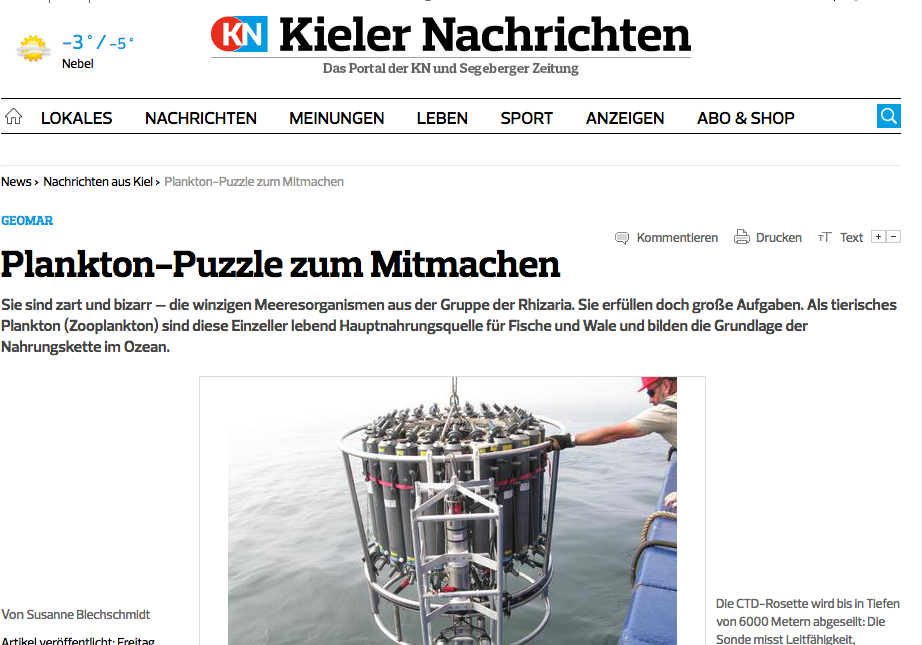
We already sorted 97 % of our current project! Click here, to check out our progress!
------------------------
23.09.2020: We are now working on the M156 data set from the tropical North Atlantic! Here you can see where the data come from and how far we are.
------------------------
23.09.2020: PlanktonID is now also available in French. Many thanks to Laetitia Drago from the Laboratoire d'Océanographie de Villefranche-sur-mer for her great help!
------------------------
19.09.2019: TRATLEQ1 starts in Walvis Bay, Namibia. We are now sailing with RV Meteor along the African coast and will conduct research off Angola for about a week.Thereafter we will steam towards the equator and then along the equator towards Brazil. We will deploy the UVP5 along the whole equatorand will collect many new pictures for PlanktonID.
------------------------
03.07.2019: We have installed the UVP5 on board of FS Meteor. It is now busy until the end of January to obtain new data from the tropical Atlantic.
------------------------
17.09.2018: We are now working on a dataset from RV Meteor cruise M148 from the southern Atlantic.
------------------------
15.09.2018: The M145 dataset from the Guinea Dome and the equatorial upwelling region is done.
------------------------
31.05.2018: We are now analyzing the M145 dataset from the Guinea Dome and the equatorial Upwelling region! region. Here you can see where the images were recorded and check the progress of the current project.
------------------------
22.12.2017: We are now analyzing the Fluxes-2 dataset from the Mauretanian-upwelling region. Here you can see where the images were recorded and check the progress of the current project.
------------------------
04.11.2017: We are now analyzing a dataset from the Mauretanian-upwelling region. Here you can see where the images were recorded and check the progress of the current project.
------------------------
06.10.2017: If you missed the radio broadcast on monday - here you can listen to it online.
------------------------
22.09.2017: On the 24th September 6-8 am and 25th September 8-9 pm, PlanktonID will be presented in a radio broadcast by NDR 90,3!
------------------------
22.09.2017: The first preliminary project results and figures are online!
------------------------
18.08.2017: We reached our project goal and sorted all available images from major upwelling areas! Now we continue with images from transect profiles that were recorded in the tropical Atlantic Ocean. Look here for an overview on the projects progress!
------------------------
27.07.2017: We started our last dataset from the Humboldt-upwelling area in the Pacific Ocean! Here you can see where the images were recorded and check the progress of the current project.
------------------------
28.06.2017: Do you know the project Plötzlich Wissen!? You can find a nice Article about PlanktonID on the website of this german science communication project.
------------------------
16.06.2017: We will present our project during the Kiel Week! Come along and have a look!
------------------------
15.06.2017: The next project has started! We are staying in the Pacific Ocean and continue with 99 new UVP profiles.
------------------------
31.05.2017: There are new features in our game! Have a look at your sorting or your profile page for further information.
------------------------
12.05.2017: The Meeresatlas 2017 came out a few days ago with an overview over the current state of the ocean (in German).
------------------------
04.05.2017: Tonight at 8:22 pm there will be a German radio broadcast about PlanktonID on NDR1 Welle Nord!
------------------------
25.04.2017: Next project finished! Let's continue with fresh images from the Pacific Ocean.
------------------------
25.04.2017: We just hit the 1 Million images! You are unbelievable :)
------------------------
05.04.2017: Wow, we are project of the month on the german citizen science platform Bürgerschaffenwissen!
------------------------
05.04.2017: We wrote a guest entry for Oceanblogs. Have a look at it here!
------------------------
23.03.2017: Have a look at the GEOMAR News 01/17 for some latest news on marine research! There is also a report about us :)
------------------------
08.03.2017: We finished the sorting of images from the Atlantic Ocean and now continue with data from the Pacific! here you can find further information.
------------------------
08.02.2017: Have a look at the first evaluations of our data!
------------------------

14.01.2017: Here you will find an article about our project in the 'Kieler Nachrichten' (in German)
------------------------
12.01.2017: Here you find a facebook post about our project.
Most organisms in the ocean belong to the so called Plankton. Plankton includes algae (phytoplankton) and small animals (zooplankton). Microscopic unicellular organisms, tiny crustaceans, fish larvae, meter-sized jellyfish and many other animals belong to the zooplankton. All planktonic organisms drift with the ocean currents.
We currently investigate Rhizaria, single-celled zooplankton organisms. Rhizaria can play an important role in carbon export from the surface to the deep ocean. We obtained a large dataset from different regions of the ocean containing thousands of images taken by an underwater camera. In our game you can help to identify the images and contribute to ocean research.
Play the game and take part in the analysis of this unique dataset!